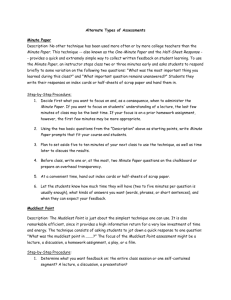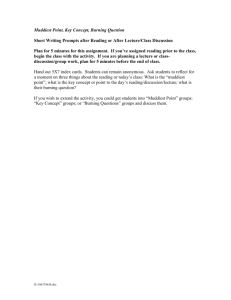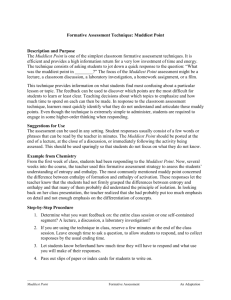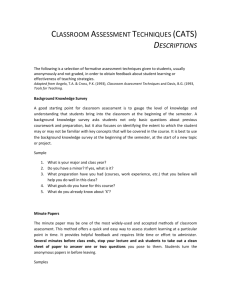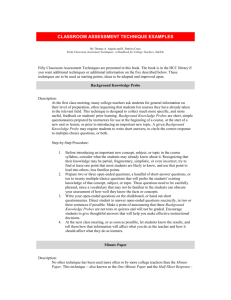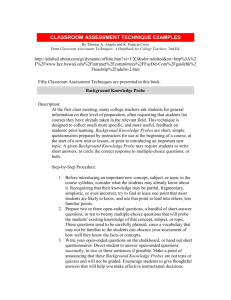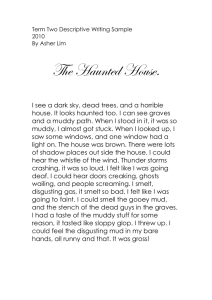Muddiest Point in the Lecture (Muddy Cards)
advertisement
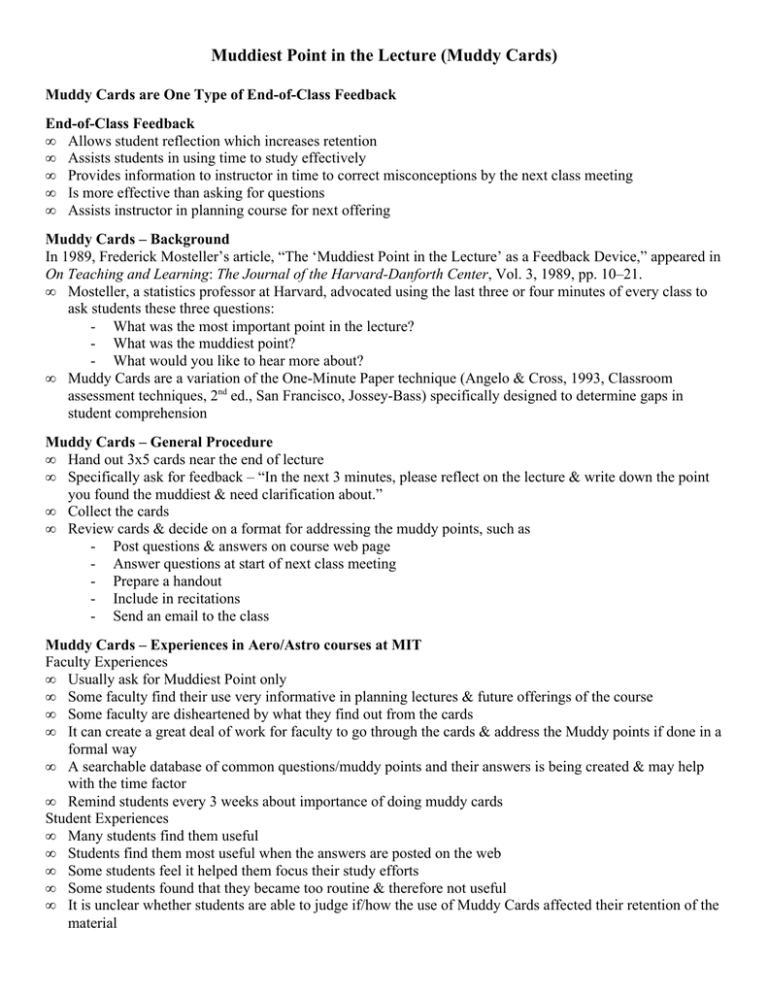
Muddiest Point in the Lecture (Muddy Cards) Muddy Cards are One Type of End-of-Class Feedback End-of-Class Feedback • Allows student reflection which increases retention • Assists students in using time to study effectively • Provides information to instructor in time to correct misconceptions by the next class meeting • Is more effective than asking for questions • Assists instructor in planning course for next offering Muddy Cards – Background In 1989, Frederick Mosteller’s article, “The ‘Muddiest Point in the Lecture’ as a Feedback Device,” appeared in On Teaching and Learning: The Journal of the Harvard-Danforth Center, Vol. 3, 1989, pp. 10–21. • Mosteller, a statistics professor at Harvard, advocated using the last three or four minutes of every class to ask students these three questions: - What was the most important point in the lecture? - What was the muddiest point? - What would you like to hear more about? • Muddy Cards are a variation of the One-Minute Paper technique (Angelo & Cross, 1993, Classroom assessment techniques, 2nd ed., San Francisco, Jossey-Bass) specifically designed to determine gaps in student comprehension Muddy Cards – General Procedure • Hand out 3x5 cards near the end of lecture • Specifically ask for feedback – “In the next 3 minutes, please reflect on the lecture & write down the point you found the muddiest & need clarification about.” • Collect the cards • Review cards & decide on a format for addressing the muddy points, such as - Post questions & answers on course web page - Answer questions at start of next class meeting - Prepare a handout - Include in recitations - Send an email to the class Muddy Cards – Experiences in Aero/Astro courses at MIT Faculty Experiences • Usually ask for Muddiest Point only • Some faculty find their use very informative in planning lectures & future offerings of the course • Some faculty are disheartened by what they find out from the cards • It can create a great deal of work for faculty to go through the cards & address the Muddy points if done in a formal way • A searchable database of common questions/muddy points and their answers is being created & may help with the time factor • Remind students every 3 weeks about importance of doing muddy cards Student Experiences • Many students find them useful • Students find them most useful when the answers are posted on the web • Some students feel it helped them focus their study efforts • Some students found that they became too routine & therefore not useful • It is unclear whether students are able to judge if/how the use of Muddy Cards affected their retention of the material Tips for Using Mudddy Cards Effectively Remind students of the student advantages of Mud Cards • Allows student reflection which increases retention • Assists students in using time to study effectively by helping them pinpoint what they don't understand optimizing their study time • Modern learning theories (e.g. constructivism) suggest that addressing misconceptions and preconceptions is critical for establishing deep conceptual learning (Wandersee, Mintzes and Novak, 1994). Mud Cards provide a data source for determining these misconceptions. • Some educational researchers believe that students pay greater attention to the lecture if they are expected to identify a muddiest point (Angelo & Cross, 1993) Advantages to Faculty • Provides information to instructor in time to correct misconceptions by the next class meeting • Assists instructor in planning the course for the next offering To Obtain Student Participation Faculty need to: • End the lecture 3 minutes early and specifically ask for feedback - "In the next 3 minutes, please reflect on the lecture & write down the point you found the muddiest & need clarification about." • Encourage participation and avoid disruption by requiring all to remain seated until the 3 minutes have passed • Respond in some way to the cards; if there is no response students get the message that their feedback is not valued. Here are some ways to respond: - Post questions & answers on course web page - Answer questions at start of next class meeting - Prepare a handout - Include in (or ask TAs to include in) recitation - Send an email to the class Some Alternatives to “Muddiest Point of the Lecture” • In addition to or instead of "What was the muddiest point?" ask • "What was the most important point in the lecture? (also called One Minute Paper)" or • "What would you like to hear more about?" or • "I was surprised to learn . . " and ask students to complete the sentence • In large classes, break students into small groups and ask each group to create a card • If the technique is getting stale, use it every two or three lectures instead of every lecture
